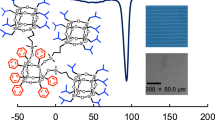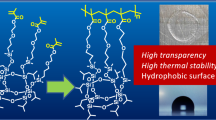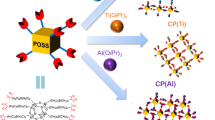Abstract
A new hybrid polyphosphazene with two symmetrical polyhedral oligomeric silsesquioxane (POSS) (polyphosphazene-POSS) units was synthesized via the corner-capping reaction of incompletely condensed POSS ((c-C5H9)7Si7O9(OH)3) (POSS-OH) and poly[bis(2,2,2-trichloroethoxy)phosphazene] (polyphosphazene-Cl). Polyphosphazene-Cl was prepared via the chlorine replacement reaction of poly(dichlorophosphazene) and 2,2,2-trichloroethoxide. POSS-OH was synthesized through the hydrolytic condensation reaction of cyclopentyltrichlorosilane under reflux in aqueous acetone. Polyphosphazene-POSS was characterized using the 1H, 29Si and 31P nuclear magnetic resonance (NMR), fourier transform infrared, differential scanning calorimetry, X-ray diffraction, thermogravimetric analysis and scanning electron microscopy techniques. This new polyphosphazene is a hybrid organic–inorganic polymer that possesses a backbone of alternating phosphorus and nitrogen atoms and two side-chain-tethered POSS pendant units as inorganic parts. The incorporation of POSS groups into the side chain of polyphosphazene improves the thermal stability of polyphosphazene-POSS because of the filler effect, and the crystallinity of polyphosphazene-POSS disappears because of the restriction of polymer orientation caused by the bulk and large volume of the POSS units. Polyphosphazene-POSS exhibit high storage stability against gelation compared with polyphosphazene-Cl. In addition, the introduction of the POSS units increases the hydrophobicity of polyphosphazene-POSS because of the enhanced hydrophobicity of the seven cyclopentyl groups attached to POSS.
Similar content being viewed by others
Introduction
Polyhedral oligomeric silsesquioxane (POSS) has attracted considerable interest because it is a well-defined organic–inorganic building block with a nano-sized cage structure that consists of a silica-like core and eight organic functional corner groups.1, 2, 3 Various POSS-based hybrid polymers or nanocomposites have been synthesized using POSS as an effective nanofiller. The incorporation of POSS into a polymer via copolymerization or blending is a simple and easy approach for producing hybrid polymers or nanocomposites with enhanced thermal and mechanical properties because of the various polymerizable substituents attached to POSS and the high solubility derived from the organic functional outer groups in POSS.4, 5, 6 In addition, the structure effect caused by the unique cage structure of POSS allows aggregates of metal nanoparticles to be obtained by using POSS as a ligand.7, 8 We reported various POSS-based hybrid polymers and nanocomposites.9, 10, 11, 12 Furthermore, we have expanded the existing research on POSS to the hybridization of POSS with carbon-based materials, such as CNTs and graphene.13, 14, 15
Polyphosphazenes consist of the linear backbone of alternating phosphorus and nitrogen atoms and two organic side groups linked to each phosphorus atom.16 Various polyphosphazenes have been fabricated by introducing different side groups or by changing the feed ratios of the side groups.17, 18 The applications of polyphosphazenes have primarily focused on fire retardants, solid polymer electrolytes and biomaterials.19, 20, 21 The low degree of crystallization and high thermal stability in polyphosphazene are required for the application of polymer electrolyte because high crystallinity causes slow ionic mobility.22
In the present work, we fabricated a new hybrid polyphosphazene containing two symmetrical POSS units in the side chain (polyphosphazene-POSS). We incorporated the POSS units into the side chain of polyphosphazene to improve its thermal stability and storage stability. The large volume of the POSS units in the side chain disturbs the orientation between the polymer chains by providing additional free volume to polyphosphazene-POSS, which results in the disappearance of melting temperature (Tm) in polyphosphazene-POSS. The hydrophobicity of polyphosphazene-POSS was increased because of the enhanced hydrophobicity of the seven cyclopentyl groups attached to POSS. In addition, polyphosphazene-POSS exhibited high storage stability against gelation compared with polyphosphazene-Cl. To the best of our knowledge, the introduction of POSS as inorganic groups into the side chain of polyphosphazene has not yet been explored. The introduction of bulky POSS side groups into polyphosphazene improves the thermal stability and retards crystallization. The high thermal stability and lack of crystallinity of polyphosphazene-POSS open the possibility for it to be used as the polymer electrolyte in lithium-ion batteries.
Experimental Procedure
General procedure
All 1H, 29Si and 31P nuclear magnetic resonance (NMR) measurements were run in CDCl3. 1H NMR spectra were obtained using a Bruker Avance 400 MHz NMR spectrometer. 29Si and 31P NMR spectra were recorded using a Bruker Ascend 400 MHz NMR spectrometer. Fourier transform infrared spectra were recorded using a Nicolet IR 200 spectrometer. The thermal behavior was examined via differential scanning calorimetry (DSC 2000, TA Instruments, New Castle, DE, USA) and thermogravimetric analysis (TGA S-1000, SCINCO, Seoul, Korea) under nitrogen and air atmospheres, respectively. The crystallinity of polyphosphazene-POSS was determined using X-ray diffraction (Rigaku Rint2000). The morphologies of polyphosphazene-POSS were observed via scanning electron microscopy (JEOL JSM-6700/LV, Tokyo, Japan). The surface contact angle was measured using a PHOENIX-300 (Surface Electro Optics, Gyeonggi-do, Korea) instrument under the conditions of 21 °C and 37% humidity.
Materials
Poly (dichlorophosphazene), 2,2,2-trichloroethanol, sodium hydride (dispersion in mineral oil), tetrahydrofuran and triethylamine were obtained from Sigma-Aldrich (St Louis, MO, USA) and used as received. Cyclopentyltrichlorosilane was purchased from JSI Silicone (Gyeonggi-do, Korea). Acetone and water was obtained from Burdick & Jackson (New Jersey, NJ, USA). Other solvents and reagents were commercially supplied and used without further purification.
Synthesis of poly[bis(2,2,2-trichloroethoxy)phosphazene] (polyphosphazene-Cl)
Polyphosphazene-Cl was synthesized according to the procedure in the literature.17 2,2,2-trichloroethanol (0.62 ml, 6.25 mmol) was added dropwise to a suspension of sodium hydride (60% dispersion in mineral oil, 0.25 g, 6.25 mmol) in THF (14 ml). The above mixture was added dropwise to a solution of poly(dichlorophosphazene) (0.3 g, 2.5 mmol) in THF (20 ml), and the mixture was then stirred for 20 h at room temperature. The reaction mixture was concentrated under reduced pressure and then precipitated from hot THF into water five times and from hot THF into hexanes twice. The precipitates were dried under high vacuum to obtain a white solid (0.42 g, 59%). 1H NMR (ppm, CDCl3): 4.63 (s, 4H). 31P NMR (ppm, CDCl3): −11.9. Polyphosphazene-Cl was analyzed by gel permeation chromatography using THF as the eluent (Mn=4900, Mw=5100 g mol−1).
Synthesis of incompletely condensed POSS (POSS-OH)
Incompletely condensed POSS was prepared using the hydrolytic condensation reaction of cyclopentyltrichlorosilane under reflux in aqueous acetone according to previously published procedures.9 1H NMR (ppm, CDCl3): 6.00 (br, 3H), 1.47–1.75 (m, 56H), 1.0 (m, 7H). 29Si NMR (ppm, CDCl3): −53.38, −64.21, −67.49.
Synthesis of polyphosphazene containing POSS (polyphosphazene-POSS)
POSS-OH (0.96 g, 1.1 mmol) and triethylamine (0.45 g, 4.4 mmol) were dissolved in THF (25 ml). The solution was cooled in an ice bath, and polyphosphazene-Cl (0.15 g, 0.44 mmol) in THF (8 ml) was added slowly to the mixture. The resulting solution was stirred for 24 h at room temperature. A white salt was formed, and removed after the reaction. Next, the mixture was concentrated to 10 ml and poured into acetonitrile. The yellowish precipitate was collected by filtration and then dried in a vacuum to produce a pale yellow solid (0.87 g, 78%). 1H NMR (ppm, CDCl3): 4.83 (s, 4H), 1.48–1.75 (m, 112H), 1.0 (m, 14H). 29Si NMR (ppm, CDCl3): −64.80, −66.25, −67.32. 31P NMR (ppm, CDCl3): −8.85. Polyphosphazene-POSS was analyzed by gel permeation chromatography using THF as the eluent (Mn=17 000, Mw=19 000 g mol−1).
Results and Discussion
The synthesis of incompletely condensed POSS (POSS-OH) and poly[bis(2,2,2-trichloroethoxy)phosphazene] (polyphosphazene-Cl) are shown in Scheme 1. POSS-OH was prepared by the hydrolytic condensation reaction of cyclopentyltrichlorosilane. Three silanol groups in POSS-OH react with Polyphosphazene-Cl to yield polyphosphazene containing completely condensed POSS groups through the corner-capping reaction. Polyphosphazene-Cl was synthesized by chlorine replacement reaction of poly(dichlorophosphazene) and 2,2,2-trichloroethoxide. Polyphosphazene-Cl had Tm at ~128 °C and exhibited rapid gelation with brown color during normal storage.
Scheme 2 presents the synthesis scheme of polyphosphazene containing POSS (polyphosphazene-POSS). Two symmetrical POSS moieties were incorporated into the side chain of polyphosphazene, which affected the thermal stability, crystallinity and hydrophobicity of polyphosphazene. In addition, the storage stability of polyphosphazene-POSS against gelation was higher than that of polyphosphazene-Cl because of the introduction of POSS to the side chain of polyphosphazene-Cl.
Figure 1 displays the 1H NMR spectra of polyphosphazene-Cl, POSS-OH and polyphosphazene-POSS. A singlet signal at 4.63 ppm as characteristic of the methylene protons next to oxygen in polyphosphazene-Cl. The signals at 6.0, 1.47–1.75 and 1.0 ppm are attributed to the protons of the silanol groups, methylene protons of cyclopentyl groups, and methine protons next to silicon atom in POSS-OH, respectively. In polyphosphazene-POSS, the signal from silanol protons at 6.0 ppm from POSS-OH were completely absent, whereas the methylene protons of the cyclopentyl groups and the methine protons from POSS-OH appeared, and the signal at 4.63 ppm from polyphosphazene-Cl was shifted to 4.83 ppm. The integration ratio of the signals at 4.83 ppm (a) and that of signal at 1.0 ppm (b) was calculated to be ~2:7.14 in polyphosphazene-POSS. This ratio is almost identical to the theoretical ratio of 2:7.
Figure 2 shows the 29Si and 31P NMR spectra of polyphosphazene-POSS. In the 29Si NMR spectra, POSS-OH exhibits three peaks at −53.38, −64.21 and −67.49, whereas polyphosphazene-POSS exhibits peaks at −64.80, −66.25 and −67.32, that is, the POSS units are incorporated into the side chain of polyphosphazene. In the 31P NMR spectra, polyphosphazene-POSS exhibits a signal at −8.85 ppm. The signal at −11.9 ppm in polyphosphazene-Cl disappeared, indicating that complete POSS substitution had occurred. The 29Si and 31P NMR spectra and the ratio of the integration intensity in the 1H NMR spectrum confirmed that polyphosphazene-POSS was successfully prepared.
Figure 3 shows the fourier transform infrared spectra of polyphosphazene-Cl, POSS-OH and polyphosphazene-POSS. In polyphosphazene-Cl, the characteristic absorption bands for C–Cl and N=P stretching appeared at 904, 725 and 1264 cm−1. In polyphosphazene-POSS, a Si-O-Si absorption band was observed at 1100–1200 cm−1 from POSS-OH but no C–Cl absorption band was observed at 904 and 725 cm−1 from polyphosphazene-Cl, indicating the successful preparation of polyphosphazene-POSS by the reaction of polyphosphazene-Cl and POSS-OH.
Figure 4 displays the X-ray diffraction curves of polyphosphazene-Cl, POSS-OH and polyphosphazene-POSS. Some sharp and distinct diffraction peaks for polyphosphazene-Cl and POSS-OH can be observed. However, when POSS moieties were incorporated into the side chain of polyphosphazene, polyphosphazene-POSS did not exhibit distinct diffraction peaks, unlike polyphosphazene-Cl and POSS-OH. The disappearance of crystallinity might be due to the introduction of POSS units as the side groups into polyphosphazene. That is, the bulky and large volume of POSS groups retard crystallization by providing additional free volume to polyphosphazene. This result was definitely confirmed by the differential scanning calorimetry data, as shown in Figure 5.
Figure 5 represents differential scanning calorimetry thermograms of polyphosphazene-Cl and polyphosphazene-POSS. Polyphosphazene-Cl exhibits a Tm at 128 °C. However, polyphosphazene-POSS reveals no Tm because of the introduction of the POSS units in the side groups. In other words, the lack of appearance of Tm was caused by the lack of crystallinity of polyphosphazene-POSS owing to the incorporation of two symmetrical POSS into the side group of polyphosphazene.
Figure 6 presents the morphologies of polyphosphazene-Cl and polyphosphazene-POSS determined via scanning electron microscopy imaging. The morphology of polyphosphazene-POSS includes a continuous phase of polyphosphazene-Cl covered with POSS particles, indicating that POSS-OH is chemically attached to the side chain of polyphosphazene.
The higher thermal stability of polyphosphazene-POSS compared with that of polyphosphazene-Cl was confirmed by the thermogravimetric analysis results, as shown in Figure 7. The temperature at 5% weight loss for polyphosphazene-Cl was 180 °C, and the char yield was 0.2% at 800 °C. In contrast, polyphosphazene-POSS exhibited 5% weight loss at 235 °C and 20% char yield at 800 °C. The incorporation of POSS units into polyphosphazene resulted in improved thermal stability and higher char yields at elevated temperatures. This result indicates that the high thermal stability of polyphosphazene-POSS is derived from the siliceous bulky POSS side groups.
The hydrophobicity of polyphosphazene-POSS was evaluated by surface contact angle measurement to water, as shown in Figure 8. POSS-OH exhibits high hydrophobicity because of the seven cyclopentyl groups. The incorporation of POSS moieties into the side chain of polyphosphazene results in the higher hydrophobicity compared with polyphosphazene-Cl because of enhanced hydrophobicity of the seven cyclopentyl groups in POSS-OH.
Conclusion
In summary, a novel hybrid polyphosphazene containing two side-chain-tethered symmetrical POSS (polyphosphazene-POSS) units was synthesized, and the structures and thermal properties of the novel material were characterized. The incorporation of the bulky POSS units into the side chain of polyphosphazene increased the thermal stability, hydrophobicity and storage stability. In addition, the crystallinity of polyphosphazene-Cl was completely disrupted in polyphosphazene-POSS because of the additional free volume of the POSS side groups. The lack of crystallinity of polyphosphazene-POSS makes it a good candidate as a polymer electrolyte for lithium-ion batteries because a highly crystalline structure inhibits ionic mobility. The research into the application of polyphosphazene-POSS on a polymer electrolyte is in progress and will be published in the future.

Synthesis schemes of POSS-OH and polyphosphazene-Cl.

Synthesis scheme of polyphosphazene-POSS.
References
Cordes, D. B., Lickiss, P. D. & Rataboul, F. Recent developments in the chemistry of cubic polyhedral oligosilsesquioxanes. Chem. Rev. 110, 2081–2173 (2010).
Leu, C. M., Chang, Y. T. & Wei, K. H. Synthesis and dielectric properties of polyimide-tethered polyhedral oligomeric silsesquioxane (POSS) nanocomposites via POSS-diamine. Macromolecules 36, 9122–9127 (2003).
Liu, Y., Yang, X., Zhang, W. & Zheng, S. Star-shaped poly(ɛ-caprolactone) with polyhedral oligomeric silsesquioxane core. Polymer 47, 6814–6825 (2006).
Fu, B. X., Gelfer, M. Y., Hsiao, B. S., Phillips, S., Viers, B., Blanski, R. & Ruth, P. Physical gelation in ethylene-propylene copolymer melts induced by polyhedral oligomeric silsesquioxane (POSS) molecules. Polymer 44, 1499–1506 (2003).
Joshi, M., Butola, B. S., Simon, G. & Kukaleva, N. Rheological and viscoelastic behavior of HDPE/octamethyl-POSS nanocomposites. Macromolecules 39, 1839–1849 (2006).
Shin, R. S., Lu, C. H., Kuo, S. W. & Chang, F. C. Hydrogen bond-mediated self-assembly of polyhedral oligomeric silsesquioxane-based supramolecules. J. Phys. Chem. C 114, 12855–12862 (2010).
Naka, K., Itoh, H. & Chujo, Y. Self-organization of spherical aggregates of palladium nanoparticles with a cubic silsesquioxane. Nano Lett. 2, 1183–1186 (2002).
Gardella, L., Basso, A., Prato, M. & Monticelli, O. PLA/POSS nanofibers: a novel system for the immobilization of metal nanoparticles. ACS Appl. Mater. Interfaces 5, 7688–7692 (2013).
Kim, K. M., Keum, D. K. & Chujo, Y. Organic-inorganic polymer hybrids using polyoxazoline initiated by functionalized silsesquioxane. Macromolecules 36, 867–875 (2003).
Kim, K. M. & Chujo, Y. Organic-inorganic hybrid gels having functionalized silsesquioxanes. J. Mater. Chem. 13, 1384–1391 (2003).
Jeon, J. H., Lim, J. H. & Kim, K. M. Organic-inorganic hybrid nanocomposites of poly(sodium 4-styrenesulfonate) and octafunctional polyhedral oligomeric silsesquioxane (POSS). Macromol. Res. 18, 341–345 (2010).
Park, D. S., Ha, T. S., Kim, K. Y., Lim, J. H. & Kim, K. M. New composites of spherical bridged polysilsesquioxanes and aggregates of Pd nanoparticles with POSS via ionic interactions. Polym. Bull. 71, 819–828 (2014).
Jeon, J. H., Lim, J. H. & Kim, K. M. Hybrid nanocomposites of palladium nanoparticles having POSS and MWNTs via ionic interactions. Macromol. Res. 17, 987–994 (2009).
Lee, J. H., Nam, J. H., Lim, J. H. & Kim, K. M. Fabrication of hybrid nanocomposites of poly(acrylic acid)-grafted MWNTs and spherical aggregates of palladium nanoparticles with POSS. Compos. Interfaces 19, 583–592 (2012).
Lim, J. H., Ko, Y. W., Kim, K. Y. & Kim, K. M. Fabrication of hybrid nanocomposites of PAA-grafted graphene and Pd nanoparticles having POSS (Pd-POSS). Polym. Korea 36, 656–661 (2012).
Allcock, H. R. The synthesis of functional polyphosphazenes and their surfaces. Appl. Organomet. Chem. 12, 659–666 (1998).
Chen, C., Liu, X., Tian, Z. & Allcock, H. R. Trichloroethoxy-substituted polyphosphazenes: synthesis, characterization, and properties. Macromolecules 45, 9085–9091 (2012).
Krogman, N. R., Steely, L., Hinderlang, M. D., Nair, L. S., Laurencin, C. T. & Allcock, H. R. Synthesis and characterization of polyphosphazene-block-polyester and polyphosphazene-block-polycarbonate. Macromolecules 41, 1126–1130 (2008).
Allcock, H. R., Kuharcik, S. E., Reed, C. S. & Napierala, M. E. Synthesis of polyphosphazenes with ethyleneoxy-containing side groups: new solid electrolyte materials. Macromolecules 29, 3384–3389 (1996).
Allcock, H.R. & Kellam, E.C. The synthesis and applications of novel aryloxy/oligoethyleneoxy substituted polyphosphazenes as solid polymer electrolytes. Solid State Ionics 156, 401–414 (2003).
Potta, T., Chun, C. & Song, S. C. Dual cross-linking system of functionally photo-cross-linkable and thermoresponsive polyphosphazene hydrogels for biomedical applications. Biomacromolecules 11, 1741–1753 (2010).
Conner, D. A., Welna, D. T., Chang, Y. & Allcock, H. R. Influence of terminal phenyl groups on the side chains of phosphazene polymers: structure-property relationships and polymer electrolyte behavior. Macromolecules 40, 322–328 (2007).
Acknowledgements
This research was supported by Basic Science Research Program through the National Research Foundation of Korea funded by the Ministry of Education (2012R1A1A2042629) and by the Ministry of Education and National Research Foundation of Korea through the Human Resource Training Project for Regional Innovation (2013H1B8A2032161).
Author information
Authors and Affiliations
Corresponding authors
Rights and permissions
About this article
Cite this article
Park, DS., Ha, TS., Lim, JH. et al. Synthesis and characterization of a new hybrid polyphosphazene containing two symmetrical polyhedral oligomeric silsesquioxane (POSS) units. Polym J 47, 415–421 (2015). https://doi.org/10.1038/pj.2015.12
Received:
Revised:
Accepted:
Published:
Issue Date:
DOI: https://doi.org/10.1038/pj.2015.12











